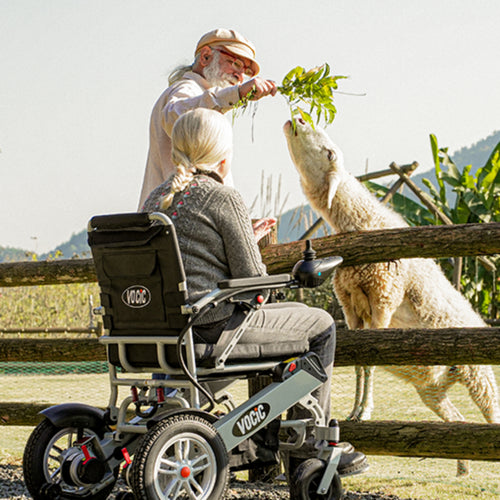Safe driving is very important in our lives, especially for older drivers. Seniors may face challenges that impact their ability to drive, but with the appropriate measures and strategies in place, seniors can safely enjoy the freedom and convenience of driving.
This article will provide practical safe driving tips to help older drivers stay safe on the road, increase their driving confidence, and drive longer.
Why Is It Risky for Older People to Drive?
Driving is increasingly risky for older adults due to various physiological and cognitive changes associated with aging. These changes may manifest as specific symptoms that directly affect the ability to drive:
-
Visual impairment: As people age, common vision problems such as cataracts, glaucoma, and macular degeneration can develop, impairing clear vision. These include difficulties with night vision, sensitivity to glare, and challenges adjusting focus between near and distant objects. These visual impairments make it more difficult to read road signs, recognize faces and vehicles, and react quickly to changes in the driving environment.
-
Response time delay: Reaction times in older adults often slow due to a natural decrease in neural efficiency. This affects their ability to react quickly to sudden stops, emergency maneuvers or other unexpected actions by drivers and pedestrians. Any delay increases the risk of an accident.
-
Reduced physical activity: Age-related conditions such as arthritis or osteoporosis can reduce physical mobility, affecting a person's ability to turn the steering wheel, use vehicle controls or effectively check blind spots. Stiff joints and muscles can also make it difficult to look over your shoulder, move quickly between pedals, or maintain control of your vehicle for long periods of time.
-
Cognitive decline: Cognitive decline may include problems with memory, attention, and problem-solving skills. This can cause difficulties with navigation, staying focused on long drives, or remembering driving rules and directions. Cognitive impairment also reduces the ability to process information quickly and make correct judgments to ensure safe driving.
-
Drug side effects: Many medications older adults take can have side effects that affect their driving skills. Common problems include drowsiness, dizziness, and decreased alertness, all of which can make driving dangerous. Some medications can also impair motor skills or cognitive function, further increasing risks on the road.
-
Increased likelihood of injury:Older drivers are more likely to be injured in accidents due to reduced bone density and overall recovery ability. Minor collisions can result in serious injuries, and recovery times are often longer and more complex, affecting their overall health and mobility.
Given these risks, older adults need to have their driving abilities regularly assessed and, if any of these risk factors significantly impair their ability to drive safely, to consider alternative transportation options.

10 Safe Driving Tips for Seniors
As a senior driver, driving safely requires good habits, awareness of your limitations, and available assistive tools. Here are ten safe driving tips for seniors to help them stay safe and confident on the road:
1. Regular Vision and Hearing Exams
Seniors should schedule regular checks to ensure their vision and hearing meet the requirements for safe driving, with frequent monitoring to address age-related changes like cataracts or hearing loss that can impact their ability to react to road conditions.
2. Avoid Driving at Night
Reduced visibility and high glare from headlights at night can greatly increase driving risks for seniors. It’s recommended to limit driving to daytime or well-lit conditions whenever possible.
3. Stay Physically Active
Engaging in regular physical activities helps maintain the muscle strength and flexibility necessary for critical driving tasks, such as turning the steering wheel and applying brake pressure effectively.
4. Plan Your Route in Advance
By planning routes before departure, seniors can choose quieter roads and avoid complex traffic situations, using GPS navigation to keep the journey as straightforward as possible.
5. Avoid Peak Times
Driving during quieter times of the day minimizes exposure to congested traffic, reducing stress and the chance of accidents, making the drive smoother and safer.
6. Review of Drugs
It’s crucial for seniors to review their medications with their doctors to understand any effects on driving ability, such as drowsiness or impaired reflexes, and adjust dosages or timing as needed.
7. Use a Safe and Comfortable Vehicle
Driving a vehicle that is easy to enter and exit, with supportive seats and modern safety features like automatic braking and rearview cameras, can enhance driving safety for seniors.
8. Limit Distractions
Seniors should keep the driving environment free from distractions by preparing GPS settings before driving, avoiding phone use, and keeping the radio volume low to focus fully on driving.
9. Refresh Your Driving Skills
Seniors can benefit from taking refresher courses that focus on current road laws, defensive driving techniques, and adapting to any new traffic regulations or changes in driving conditions.
10. Know When to Stop
Regular self-assessment and open discussions with family and healthcare providers about driving abilities can help seniors decide when it is time to retire from driving to ensure their safety and others on the road.
By following these tips, older drivers can improve road safety and enjoy a more comfortable driving experience while dealing with the challenges of aging.
Signs Older People No Longer Drive
Knowing when older adults should stop driving, and knowing how to improve these signs to improve their ability to drive, can provide necessary support and safety. Here are some clear signs that older adults may want to consider tinkering with driving:
-
Reaction times are significantly reduced: If older drivers are slow to react to emergencies or everyday traffic situations, this increases the risk of an accident.
-
Vision Problems: Vision is very important for safe driving. If a senior has difficulty seeing road signs or vehicles or has difficulty driving at night, this is a warning sign.
-
Memory loss: Frequently forgetting your destination, taking wrong turns, or getting lost can be signs of cognitive decline, which can be extremely dangerous when driving.
-
Hearing Impairment: If older adults cannot hear emergency vehicle sirens or traffic signals, they may not be able to respond promptly, which affects driving safety.
-
Physical limitations: Joint pain, reduced muscle strength, or reduced flexibility can affect driving maneuvers such as turning the steering wheel or using the brakes and accelerator.
After recognizing these signs, family members and healthcare providers can take steps to help older adults improve these conditions. Regular physical exams, appropriate vision and hearing correction, and potential cognitive function training. Through these methods, seniors can safely continue to drive for as long as possible until they need to stop driving.
Other Get-Around Ways for Older People
When a senior decides to stop driving, it's important to understand alternative transportation options that maintain their independence and mobility. Here are a few possible transportation alternatives:
-
Mobility Scooters and Electric Wheelchairs: Mobility scooters and electric wheelchairs enable seniors to maintain independence over longer distances, with features like extended battery life and adjustable speed settings for various indoor and outdoor activities.Therefore, when purchasing alternative transportation, you can choose VOCIC’s scooters and wheelchairs.
-
Public Transport: Public transport offers a convenient network of buses, trains, and tubes with senior-friendly features such as low-floor access, priority seating, and audible stop announcements. Discounted fares make it a cost-effective travel option for seniors.
-
Community Shuttle: Community shuttles cater specifically to seniors, providing fixed routes to essential destinations like medical centers and shopping malls. These shuttles feature easy access with ramps and lifts for those with mobility issues.
-
Carpooling Service: Ride-sharing services like Uber and Lyft provide flexible, on-demand transportation for seniors via apps. Features include assistance on request, disability-friendly vehicles, and safety tracking by family members.
-
Walking and Cycling: For active seniors, walking and cycling are encouraged through community efforts that include safe, pedestrian-friendly paths and dedicated bike lanes.
-
Paratransit Service: Paratransit services offer door-to-door transport for seniors and individuals with disabilities who cannot use standard public transport, requiring advance registration and booking for personalized assistance.
-
Relatives and Friends: Traveling with family and friends provides seniors with not only mobility but also valuable companionship, aligning transport with shared schedules for ease and enjoyment.
-
Premium Car Service: Specialized car services for seniors feature trained drivers and vehicles equipped with accessibility tools like ramps, ensuring every trip is comfortable and tailored to senior needs.
Every alternative transportation option has its benefits and can be combined based on a senior’s health, mobility level, and local availability, ensuring they can continue to live an active and fulfilling life without driving. Also, VOCIC also provides alternative transportation options with four-wheel walkers. If you are interested, you can consult the VOCIC website.

Conclusion
Keeping older drivers safe on the road requires taking appropriate precautions, including regular health checks, adaptive driving skills training, and the use of supportive driving techniques and tools.







